
Topics
Guests
- George KatsiaficasProfessor of Humanities and Sociology at the Wentworth Institute of Technology in Boston. He is the author of numerous books, including The Imagination of the New Left: The Global Analysis of 1968.
May 1968 was a watershed month for France, when a wave of student and worker protests swept the country and changed French society forever. We speak to George Katsiaficas, author of numerous books, including The Imagination of the New Left: The Global Analysis of 1968. [includes rush transcript]
Transcript
AMY GOODMAN:
We begin today with our latest edition of “1968: Forty Years Later.” May 1968 was a watershed month for France, when a wave of student and worker protests swept the country and changed French society forever.
It began when university students in Paris occupied the area of the Sorbonne and Nanterre universities in response to a dispute over visiting rights to a female students’ dormitory. The protests grew into a call for wider university reforms and greater personal freedoms that led to three weeks of mass demonstrations. Hundreds of thousands of people took to the streets to protest heavy-handed police treatment. In a show of solidarity, ten million workers, or roughly two-thirds of the French workforce, went on strike. It marked the biggest general strike in French history.
This is one of the 1968 student leaders being questioned at the time at a news conference in Paris.
REPORTER: Could you tell us what your purpose is in being here?
DANNY COHN-BENDIT: Continue, continue politic [inaudible].
REPORTER: Could you tell us whether you’re for the overthrow of capitalist governments in France, in the United States, in Germany?
DANNY COHN-BENDIT: Yes, yes, everywhere.
REPORTER: By violent means?
DANNY COHN-BENDIT: Not again this question! You have heard what I said to your English confreres. I said that I want overthrow if the capitalist system, to defend its privilege, is taking violence, we will defend us with violence. OK?
AMY GOODMAN:
The French protests reached such a point that President Charles de Gaulle created a military operations headquarters to deal with the unrest. He dissolved the National Assembly and called for new parliamentary elections.
George Katsiaficas is a professor of humanities and sociology at the Wentworth Institute of Technology in Boston. He’s the author of many books, including The Imagination of the New Left: The Global Analysis of 1968. He joins me in our firehouse studio. Welcome to Democracy Now!
GEORGE KATSIAFICAS:
Thanks for having me on the show, Amy.
AMY GOODMAN:
Talk about what happened in May 1968 in France. Set the scene.
GEORGE KATSIAFICAS:
Well, in 1968, there was a global movement against the United States and against capitalism, as well as against the Soviet Union and the Soviet variety of socialism. And the relationships of those movements to each other is, I think, one of the primary reasons that we see France erupt. In fact, in his new year’s address in 1968, de Gaulle said that France, of all countries, was an example of peace and social tranquility. But as you say, by May ’68, it was the biggest strike in the history of France, a wildcat insurrectionary general strike that called for the overthrow of capitalism.
Essentially, disciplinary hearings against students who had been trying to be treated as adults and not as children turned into police brutality of an unprecedented level, and students refused to take the violence against them. The student governments in all of France voted to support these students who were being put on disciplinary trials, and the police arrested the student government leaders when they congregated in Paris. The vans — much like the free speech movement in Berkeley, the vans taking away the arrested students were surrounded. One of the vans never made it out. The prisoners were released. And the then police attacked. Students counterattacked. The residents of the Latin Quarter supported the students. The special riot police that had been created after the workers’ strikes of 1958 were then mobilized, and workers instinctively sided with the students.
Soon, within a few weeks, there were ten million workers on strike in France, and no one knew what they wanted. The Communist Party negotiated with the government, trying to legitimate its own role in the society, and got a 35 percent pay raise for more than a million workers, ten percent general pay raise, a reduced workweek, better benefits, lower retirement age, and workers rejected it. Workers booed them off the stage, threw their lunches and beer bottles at them and said, “No, we want an end to capitalism. We don’t want to work in factories for the rest of our lives in exchange for some consumer goods. We want a free society.” So no one really knew what to make of the situation.
AMY GOODMAN:
Yet Charles de Gaulle was reelected?
GEORGE KATSIAFICAS:
He absolutely was reelected, in part because elections are so small a segment of the population, involving a one-minute act in a booth, but also in part because there was no clear alternative that emerged at that moment. Student leaders like Danny Cohn-Bendit didn’t believe it was possible, when push came to shove, to take over the government. The Stock Exchange was set on fire. But the Parliament building, which hundreds of thousands of people had marched past, remained as it was before the uprising.
AMY GOODMAN:
Last year, when Nicolas Sarkozy was running for president, he blamed the legacy of 1968 for leading to intellectual and moral relativism and hedonistic individualism.
GEORGE KATSIAFICAS:
Yes, and I think here in the United States, we heard similar comments from people like Richard Nixon and George Bush. In fact, the legacy of 1968 involves greater freedoms for women and homosexuals —
AMY GOODMAN:
At the time, homosexuality was a crime. Women couldn’t wear pants to work. They needed their husbands’ approval to even open a bank account.
GEORGE KATSIAFICAS:
Exactly.
AMY GOODMAN:
There was one TV channel that had to have government approval to get the news out.
GEORGE KATSIAFICAS:
Abortion rights. Students’ lives were forever changed. Young people have much greater freedoms. Minorities in France, despite continuing setbacks, at that time were everywhere welcomed in the factories’ strike committees and said they felt at home in France for the first time. So what you had really was a thoroughgoing cultural shift.
Now, capitalism, the world system, has benefited from every upsurge against it. If we look at the 1830, 1848, the Paris Commune, even the Russian revolution has strengthened the world capitalist system. So May ’68, like other events, has also worked to strengthen the capitalist system or, as Regis Debray put it, to “Americanize” French capitalism.
AMY GOODMAN:
How did the protest end?
GEORGE KATSIAFICAS:
The protests ended as individual factories were compelled to go back to work. Some factories held out. Massive police presence was used to bring them to leave their occupied factories. But remember, this was a strike that erupted out of nowhere. And it involved, as it emerged, workers in one factory welding the doors shut to their managers’ offices, so the managers were kept hostage until they would agree to negotiate with these wildcat strikers. But the overwhelming majority of the people didn’t know how to proceed further. The society had come to a halt, and there was no socially legitimate hegemonic bloc that could lead people forward in a direction that made sense to people.
AMY GOODMAN:
Professor Katsiaficas, put this in a global context.
GEORGE KATSIAFICAS:
Well, when we look at 1968, I think Hegel’s understanding that world history moves from east to west is verified. We had the Vietnamese Tet Offensive, in which every major American military base was simultaneously attacked in a surprise offensive. The Vietnamese had timed it so that the South Vietnamese troops fighting on the side of the United States were all home for the holidays, and so the guerrillas were able to attack directly American troops and overwhelm them. Although they suffered heavy losses, it set off a worldwide dynamic. And all throughout the world, from the Chinese Cultural Revolution, the Naxalite movement in India, the Czechoslovakia Prague Spring —
AMY GOODMAN:
Which was?
GEORGE KATSIAFICAS:
Which was an uprising against Soviet domination of Czechoslovakia that led to half-a-million Russian troops being brought into Czechoslovakia to occupy it. The French May events, which sparked movements in places like Senegal, Spain, Italy, Mexico City.
AMY GOODMAN:
What happened in Senegal and Spain and other places?
GEORGE KATSIAFICAS:
In Senegal, there was a student strike. In Spain, there was a strike of students and workers. In Italy, students acted directly in solidarity, attacking the French embassy. In Mexico City, students modeled themselves on what had happened in France. As we know, hundreds of students were killed in Mexico City in October, before the arrival of the 1968 Olympics. But this is the year in —
AMY GOODMAN:
And, of course, in those Olympics was the famous Black Power salute to black athletes from the United States.
GEORGE KATSIAFICAS:
Absolutely. This was also the year when Martin Luther King, Jr. was assassinated in the United States. And in more than 150 cities, there were riots. More damage was done to the city of Washington, D.C., than had been done by the British when they captured the city during the War of 1812. The Pentagon estimated it did not have enough troops to fight the war in Vietnam and to maintain order at home. This was truly a world historical year.
The high point of the US movement — that is, our May ’68, if you will — came in 1970, from May to September. We had the killings at Kent State and Jackson State Universities, in response to which a strike of four million students and half-a-million faculty — that is the largest strike in the history of the United States — erupted on the campuses. We had the women’s strike for peace and against patriarchy in New York, the Chicano Moratorium in Los Angeles on August 29, in which journalist Ruben Salazar was killed by police. And to cap it off, the high point was more than 10,000 people gathering in Philadelphia in response to the Black Panther Party’s call to write a new constitution for the United States. This new constitution was internationalist. It called for an abolition of a standing army, its replacement by popular militias. It called for complete liberation of women, for communal spaces to be set aside for children to be free. It was truly a break with the established system, much like the French May events in 1968.
AMY GOODMAN:
And yet, what came of it?
GEORGE KATSIAFICAS:
Well, again, in the United States, we have these next generations coming up that have integrated school systems in many cities — I can’t say everywhere, as we know segregation continues to plague the society. But we certainly have increased rights for minorities in the United States. Women’s status and position has changed drastically in the United States, abortion rights being just one indication. Gay liberation now is pretty commonly accepted. Of course, there’s still pockets of places that just haven’t been affected. But I think, again, in general, there was a cultural shift that led to greater freedoms for people who are different or who are perceived to be different.
AMY GOODMAN:
George Katsiaficas, you actually live in South Korea and are writing your next book on the people’s protest, the people’s movements of Asia. What was happening then there?
GEORGE KATSIAFICAS:
Well, in 1980, Kwangju, South Korea have an uprising against the military dictatorship, in which hundreds — some people say as many as 2,000 people — were killed. But what happened was that the people went up against flamethrowers and machine guns with two-by-fours and shovels and ultimately drove the military out of the city and held it for a week.
In that week, they had daily meetings of tens of thousands of people, sometimes hundreds of thousands of people, and enacted a form of participatory democracy to make decisions and manage the city. Many of the policemen in the city joined the insurrection. The police chief of the city had refused to order his troops to open fire on people, and the military took him away and tortured him. The workers in Asia Motors who were manufacturing automobiles and as well as armored cars gave the newly produced armored cars to the insurgents. Women textile workers from Naju, busloads of them, brought weapons from police stations outside of Kwangju. The miners in Hwasun brought dynamite and blasting caps. So the military was held at bay. People were able to negotiate the release of prisoners in exchange for some weapons. They were able to negotiate for more coffins for the dead. And ultimately they were overwhelmed with military force backed by the United States.
Seven years later, when news of Kwangju finally had reached the majority of South Korea, there were nineteen consecutive days of illegal demonstrations involving hundreds of thousands of people, and the military was compelled to grant direct presidential elections and greater democratic liberties in South Korea. As in 1968, though, we had an international, what I call “Eros effect.” In other words, the movement in Kwangju helped spark movements all over Asia: ’86, the Philippines; ’87 in Korea and Taiwan; ’88, the Burma uprising, in which tens of thousands possibly were killed; ’89, we have the Tibet uprising, Tiananmen Square; ’90, Bangladesh, Nepal; ’92, Thailand. Each of these movements has its own story of success and failures.
AMY GOODMAN:
George Katsiaficas, I want to thank you for being with us. I look forward to that book on the Asian popular uprisings. His latest, The Imagination of the New Left: The Global Analysis of 1968.

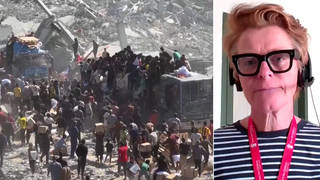
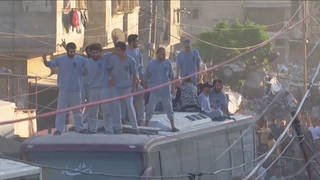
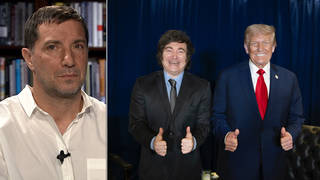
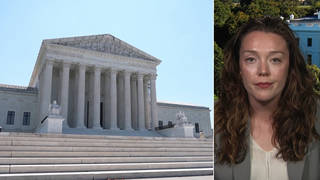





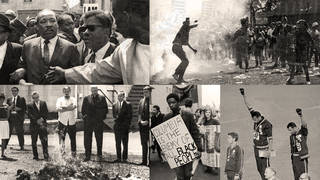
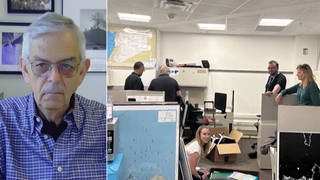
Media Options